This is a No.1 Autographic Special made by the Eastman Kodak company between 1915 and 1920. While Kodak was not known as a maker of high end cameras with top of the line specs, this camera was the exception to that rule. Costing upwards of $50 (over $1300 today), this camera had a state of the art shutter and lens, incorporated many firsts such as the first Kodak to use Bakelite plastic, and was one of the best cameras of its era.
Film Type: 120 Roll Film (8 6cm x 9cm exposures per roll)
Lens: 101mm f/6.3 uncoated Zeiss Kodak Anastigmat 4 elements
Focus: 6′ to Infinity
Type: Scale Focus
Shutter: Wollensak Optimo No. 1
Speeds: T, B, 1 – 1/300 seconds
Exposure Meter: None
Battery: None
Flash Mount: None
Manual (similar): http://www.cameramanuals.org/kodak_pdf/kodak_no1_autographic_special.pdf
History
Now that I have a couple of reviews under my belt, I’m starting to write reviews for cameras made by companies I’ve already talked about, so rather than repeat something I’ve already written, if you’re interested in a little background about Kodak, you can read some of the history that I typed in my review for the Kodak Retina IIa.
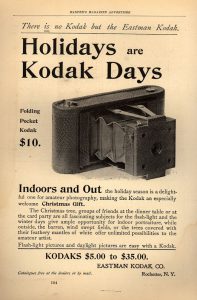
The earliest Kodak cameras were box cameras similar to the Brownies of the early 1900s. The original Kodak camera from 1888 used a type of film that wasn’t changeable by the user. When the camera was purchased, it came preloaded with enough film to shoot up to 100 exposures. Once the film was used up, the user would return the entire camera to Kodak to have the film developed and the camera reloaded. In 1895, the first roll film camera was released that used a primitive type of film that could only be loaded in a darkroom. It wasn’t until 1898 that Kodak released the first folding camera to use roll film. The 1898 Pocket Kodak was released and used type 105 roll film which took 2¼” × 3¼” frames on a roll that looked very similar to 120 format roll film, but with different flanges.
These early folding Kodaks resembled “Vest” cameras where the front lens element was always visible from the front of the camera. The camera had to be opened via a scissor mechanism which would move the front lens and shutter away from the body of the camera connected by a leather bellows. It was not until around 1905 when the first folding cameras were released which had a door that covered up the entire lens and shutter assembly when folded.
The name “Special” had been used by Kodak as far back as the 1890s to signify a higher end model with more advanced features, but the first Special folding camera was the aluminum bodied No.3A Special Kodak from 1910. More Special models followed using different film sizes, and then in 1914, the first two Autographic cameras were released called the No.1A Autographic Junior and Autographic Specials which both used 116 roll film. In order to take advantage of the autographic feature, special autographic film needed to be used.
Autographic film was invented in 1914 by a man named Henry Jacques Gaisman. Mr Gaisman had previously invented the safety razor while working for a competitor to the Gillette Razor company. His company would later be acquired by Gillette and he would later run the company. His invention for autographic film was bought by Eastman Kodak in 1914 for the price of $300,000 which was an incredible amount of money for the time.

In 1915, the No.1 Autographic Special was released. It was the third camera that supported the use of autographic film, but the first to use the smaller 120 roll film. The autographic feature worked using a door on the back of the camera that could be opened to expose a small part of the
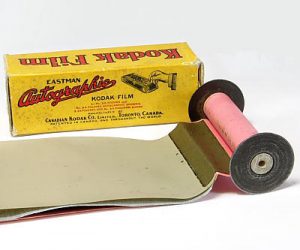
back of the film. Autographic film had two layers of paper backing instead of the conventional single layer. The outer paper backing was ever so slightly translucent so that direct light could penetrate it. The inner paper backing was a carbon impregnated material that was opaque, but would be rendered translucent whenever a sharp instrument pressed against it and compacted the carbon compound. The film came on a spool like any other standard roll film. It was loaded into the camera and the outer paper backing had exposure counting numbers on it that could be seen through the little red window on the back of cameras like typical roll film.
Whenever the photographer wanted to make a note about a particular picture he was taking, the little door was opened and a metal stylus was used to write a message on the little portion of paper backing exposed in that space. The pressure of the stylus caused the inner carbon layer to compact and become translucent under the tip of the stylus, allowing light to imprint a message on the film. When the film was developed, you would see the message along the margin of the photograph. Think of this like a very early example of EXIF data!
 Over the course of the next 15 or so years, the autographic feature would be included on almost every folding Kodak made. Kodak did not charge extra for autographic film as opposed to non-autographic film, but nevertheless, it didn’t seem to be very successful.
Over the course of the next 15 or so years, the autographic feature would be included on almost every folding Kodak made. Kodak did not charge extra for autographic film as opposed to non-autographic film, but nevertheless, it didn’t seem to be very successful.
Perhaps the biggest downfall of autographic film is that in order for it to work, one of the layers had to be semi-transparent to allow light to expose the film. Autographic film was pretty slow, probably around ASA 12, and required quite a bit of light to imprint an image. As more and more sensitive film was being released, it became harder to retain the autographic feature on faster films because the more sensitive film could more easily be accidentally exposed. By the early 1930s, autographic film was discontinued by Kodak. It was never offered by any other film maker.
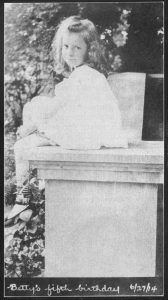
When this camera was released, autographic film was an exciting new feature, but Kodak didn’t stop there. The word “Special” was included in the name of this camera because it truly was special. Up until this point, Kodak hadn’t really been known for high end cameras. George Eastman’s philosophy was to put a camera in the hands of anyone who wanted them. He felt that photography shouldn’t be reserved only for the elite. He had the idea that if he could build and sell inexpensive cameras to lots of people, that Kodak stood to make much more profit by recurring purchases of film. The earliest Kodak Brownie from 1900 sold for $1 and a roll of film was 15 cents. This concept was revolutionary at the time and is still used today with smartphones.
The No.1 Autographic Special had several other features which were state of the art at the time. First, was the Optimo shutter from Wollensack with a top speed of 1/300th of a second. The Optimo shutter was first released in 1909 and was the world’s fastest shutter at the time. It was so fast that it was used by a number of camera makers on a wide variety of large and medium format models. The Optimo shutter was sold for over 20 years and eventually lost out to more advanced shutters like the Compur in the 1930s.
 One of the ways in which Wollensack was able to achieve such fast shutter speeds was through some creative engineering of the shutter blades. Unlike most leaf shutters, when the shutter is fired, the blades don’t open like a normal iris, rather they rotate in a fixed position. The blades have a unique design that opens and closes 180 degrees from their original positions. When fired a second time, they open and close in the opposite direction. The rotating shutter blades have the effect of creating a “star” pattern when they open. To the left is a drawing of this star pattern on a partially opened Optimo shutter.
One of the ways in which Wollensack was able to achieve such fast shutter speeds was through some creative engineering of the shutter blades. Unlike most leaf shutters, when the shutter is fired, the blades don’t open like a normal iris, rather they rotate in a fixed position. The blades have a unique design that opens and closes 180 degrees from their original positions. When fired a second time, they open and close in the opposite direction. The rotating shutter blades have the effect of creating a “star” pattern when they open. To the left is a drawing of this star pattern on a partially opened Optimo shutter.
The advantage of the rotating shutter blades is that the overall amount of movement of each blade is minimized allowing it to open and close quicker. I read on another site that the shutter blades are not made out of metal like on most leaf shutters. Instead, they are made of a lighter weight composite material which has less inertia which aides in quicker shutter speeds.
In addition to the fast speeds of the Optimo, another feature was that it was also capable of slow speeds as well. In the early 20th century, many shutters only had 1 or 2 speeds. Of the ones that had more than 2 speeds, very few of them could reliably fire at anything less than 1/25th of a second. In later years, gear driven mechanical governors were installed in cameras to slow down the shutter to speeds up to 1 second in duration. If you fire the shutter at a slow speed on almost any mechanical camera made in the 20th century, you can hear the governor grinding away like the sound of a clock being unwound. The Optimo shutter had an air-driven piston and cylinder “dashpot” that modulated the slow speeds. The dashpot is the chrome protrusion at the 5 o’clock position on the face of the shutter. In addition to offering slow speeds, it was also very quiet. When you fire the Autographic Special with a 1 second shutter speed, you only hear the clicking sound of the shutter opening and closing. The gear driven sound familiar to almost every other mechanical camera is not present.
Despite all of these advancements, the Optimo shutter has one disadvantage which is that the speeds were inconsistent depending on outside temperature and other environmental variables. Since air was used to control the speed of the shutter, in colder temps, the shutter would operate slower, and vice versa when it got warm. Still, the fact that a single camera was capable of such a wide selection of speeds, and both T and B modes was amazing for the era.

Moving beyond the shutter, the Autographic Special offered a wide variety of advanced lenses for the time. The particular model in my collection has the Zeiss Kodak Anastigmat f/6.3 lens. A 4 element Tessar design, the lens itself was built for Kodak by Bausch & Lomb out of Rochester, NY. Although uncoated, this lens has a state of the art design and was capable of excellent clarity and sharpness. The design of the lens was owned by Zeiss-Ikon from Dresden, Germany. Zeiss was in the business of outsourcing their designs to other companies who would physically build the lenses, but incorporate the Zeiss brand name into the final lens. This is why the lens is labeled “Zeiss Kodak”. After World War I started, the “Zeiss” label was no longer used, and later designs are labeled with the name Bausch & Lomb on the face of the lens plate.
The Zeiss Kodak Anastigmat was the “middle tier” lens offered in this camera, selling for $45, it was above the base level Cooke Kodak Anastigmat which sold for $36, and the top of the line Zeiss-Tessar Ic f/4.5 which sold for $56. Still, $45 in 1915 translates to $1,054 in 2015 dollars. This was not a cheap camera.
My research shows that after World War I started, the names on the lenses changed although they were still based off Zeiss’ Tessar designs. Several other variations were offered until this model was replaced in 1921 by the Model B which had several significant changes, including a new shutter, body design, and different lenses. I found information saying this model continued to sell in export countries like the UK until 1923. The easiest way to tell if you have a UK model is that the Wollensack Optimo was sold under the name “Velosto”. It is also possible to find a UK variant of the Autographic Special with a Compur shutter instead of the Optimo, but there is no evidence that the Compur was available on US models.
But wait, theres more! In addition to the excellent shutter and lenses offered on the Special, the body of the camera was made out of aluminum and brass covered in a deeply textured seal skin leather. The seal skin leather on my example is so well preserved, that it is still very soft and supple.
While brass was a common material for cameras of the era, aluminum was a little less common. Even less common than aluminum was Bakelite plastic. Bakelite was a new synthetic material, similar to modern plastic, that was invented only 8 years earlier in 1907. Bakelite was used in a huge variety of inexpensive cameras from the 1930s – 1950s due to low cost and its strong, non-conducting properties. In the mid 20th century, Bakelite was associated with low-end cameras, but in 1915, it was still a new material that would have seemed exotic at the time. The side panels of the Autographic Special are single pieces of black Bakelite with a beautiful textured pattern. Its worth noting that when the Model A Autographic Special was discontinued in 1920, the Model B that replaced it did not have the Bakelite sides.

Every aspect of the design of the Autographic Special was well thought out. When opening the front of the camera, the grip at the base of the lens assembly is large and easy to grip. The lens assembly slides easily on the track until it reaches the fully extended position. The shutter release plunger is all metal and moves very smoothly. This smooth action allowed for more stable hand-held shots without the need for a shutter release cable. Inside of the film compartment there is a dual film pressure plate that keeps consistent pressure on the edges of the film to assure that the film lies as flat as possible. The focusing mechanism is a “rack and pinion” design where you slide a lever back and forth and that moves the front lens element to an appropriate position. There is even a screw for fine adjustment of infinity focus located behind the kickstand on the front of the camera. The viewfinder was large and bright for its day and folds to the side for portrait or landscape photos. Still a bit difficult to use when compared to cameras from later in the 20th century, but if you wanted, you could take indoor photos with the built in viewfinder. I’ve read some articles from other people who own this model camera and they recommend using an external folding viewfinder taped to the side plate of the camera.
Finally, one last really cool design element of this camera that deserves it’s own explanation is in how the film loads. For one, this camera opens differently than any other folding camera I’ve seen. To open it, you position the back of the camera facing up and the red window to the right. Above and to the right of the red window, you’ll see a round circle with a slight protrusion in the leather. This is a button which releases a locking pin which allows you to slide open the back of the case. On mine, the case opens very easily and very smoothly. Once the back has been opened, you can separate the back from the rest of the camera. The Model B Autographic Special does not open this way. Perhaps Kodak deemed it to be too complicated, or perhaps it opened up the possibility for more light leaks, but its a cool design and something that really adds to this camera’s uniqueness.
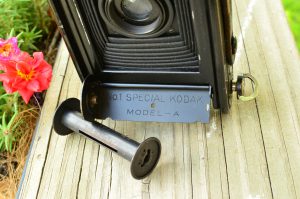
Once the back of the camera is open, another cool design element is that the mounting area where the takeup spool and film spool get loaded can swing out by about 90 degrees making spool insertion and removal a snap. The film spool side has an additional hinge that not only swings out about 90 degrees, but it can swing up making loading new film incredibly easy. Take a look at the picture to the left showing the hinged mounts. Although I can find no evidence of this, Kodak could have advertised this feature as the worlds first “Quick Load” system, much like Canon did with their SLRs and Rangefinders in the early 1970s.
So, as you can see, the No.1 Autographic Special isn’t just another Kodak folding camera. It’s a shame in some ways that Kodak didn’t continue with the theme of higher end “Special” cameras since they really did a great job with this one. Some of the design elements like the swing out mounts for film, the rack and pinion focus, and Bakelite side panels aren’t common, and I’ve personally never seen them on any other camera.
Kodak sold approximately 18,000 copies of this camera between the years of 1915 and 1920 before replacing it with the significantly redesigned Model B. I can reasonably date my example to mid 1916. My first clue is that inside of the film compartment is a list of patent dates engraved into the metal. The most recent patent date is February 1, 1916. Since its unlikely Kodak would have printed a future date on the camera while making it, this camera would have had to been manufactured after February 1st.
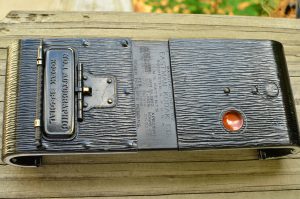
My research shows that around the time World War I started, Kodak stopped including the “Zeiss” name on their lenses. Since mine has the name, it has to be a pre-war model. A post on the Vintage Camera Collectors group on Facebook from a man named Richard Mean suggests that the Zeiss name was discontinued in May of 1916.
Another post on Photo.Net by a man named Dan Fromm suggests that the Zeiss name was discontinued in 1915, but that cannot be right because of my 1916 patent date. Dan does say that he has a collection of Zeiss Kodak Anastigmat lenses and the highest serial number he’s ever seen is 2064387. Mine is 2110736 which is higher than his, so that at least indicates that mine is probably one of the very last examples that still had the “Zeiss” label. Whether or not May 1916 was truly the cutoff date is anyone’s guess, but I feel safe in concluding that mine had to have been made somewhere around that time.
My Thoughts
My journey into vintage cameras actually started with a Kodak folding camera. My very first camera related post on this site was my announcement that I had bought an 85 year old camera. I honestly cannot remember why I decided to do it. I guess one day I was bored and on eBay (a really bad combination) and bid on a nice looking folder. I believe I paid $20 for it.
Frankly, I didn’t know anything about it. I had no idea that it took 116 film, which hadn’t been produced since the mid 1980s. I didn’t know that this would be the “gateway” camera into a wonderful hobby of collecting old cameras.
 After getting the camera cleaned up, and fabricating my own 116 to 120 film adapter using metal washers from the hardware store, some superglue, and a ground up piece of plastic from one of those “cake” shaped spindles from inside of a 50-pack of blank CD-Rs, I was able to load 120 film into my camera.
After getting the camera cleaned up, and fabricating my own 116 to 120 film adapter using metal washers from the hardware store, some superglue, and a ground up piece of plastic from one of those “cake” shaped spindles from inside of a 50-pack of blank CD-Rs, I was able to load 120 film into my camera.
Loading the film using my adapter meant that the numbers on the paper backing of the film would not line up with the red window on the back of the camera, so I had to sacrifice a roll of film and practice with it, making markings approximately where I would have to wind the film in order to not overlap my shots. I was able to figure out the frame spacing to get 6 shots from a roll of film. If you ever do this yourself, stopping near the 2.5, 5, 7.5, 10, 12.5, and 15 frames will get you 6 shots.
After learning the ropes of this camera, I shot a couple of rolls with it, and frankly, I was impressed that it all worked. None of the photos would win me any awards, but I was happy that I got an 85 year old camera to work and the shots weren’t bad.
After that camera, I decided to move into slightly newer cameras, and thus my collection started. Many of the later cameras that I’ve bought have been reviewed here. As much as I like that first camera, it is annoying to load, my adapter is very finnicky, and if you dont get it inserted into the camera back correctly, it can fall out, and you have to be super careful to get the frame spacing correct. After shooting those first couple of rolls, that camera has stayed on my shelf.
I didn’t have much interest in many other folders until I read about the No.1 Autographic Special on Mike Connealy’s website. He called this a state of the art camera for its time and goes on to say “Kodak made every effort to make purchasers happy with their decision; the features, materials and construction that went into the camera were extraordinary then, and even three quarters of a century later the camera can still be used with little sense of compromise.”
I was intrigued, the problem is that there were SO many folding cameras made by Kodak and other companies which all look very similar, that when they come up for auction, the descriptions are almost always wrong. There are huge differences between No.1 and No.1A cameras. If the camera says Jr in its title, its a totally different model as well, even Kodak made two completely different cameras called the No.1 Autographic Special. To find the exact one Mike was talking about would be a challenge. Occasionally one would come up for sale, but usually when a seller knows what they have, they ask an appropriately high price for it.
One day, I found a camera listed simply as a “kodak autographic No. 1”. The seller’s description was only one line and he said that the shutter didn’t appear to work. The opening bid was only $1, and based on the pictures, I could clearly see the Optimo shutter, so I knew exactly what it was. I typically try to keep my purchases as cheap as possible, so I set my max bid to $20, and as it turns out, that was enough, because I was the winning bidder. Including shipping, I paid $27.88 for this camera.

When it arrived, I was immediately pleased with the condition. This camera was clearly taken care of and stored well. The original box is in great shape and you can still clearly make out the name of the camera embossed into the box. Inside the box is a manual for a Kodak No.1 Autographic Special, but sadly, its for the later Model B version. This is the same exact manual that is on Mike Butkus’ camera manual site. I have not ever seen a manual for the Model A. Even though its not the same manual, it was in excellent condition and it was very fascinating to read through. There is a lot of photography information about composing photographs that still applies today.
After doing a quick once over, I drew my attention to the shutter which the seller said wasn’t working. Knowing that these were well built cameras, it had to be a mistake. The seller clearly didn’t put much effort into this listing, so I just figured that he or she didn’t know how to use the camera.
Thankfully, I was correct. The camera was in the “T” position which means the shutter will open and stay open until you press the shutter plunger a second time. The shutter speed selector was a bit stiff, but I was able to loosen it up by turning it back and forth a couple of times.
I was very pleased that once I selected other speeds, the shutter fired properly. I did notice that once the shutter plunger was pressed, it would take a second or two to return to its original position. There must be some type of drag caused by gunk causing it to move slowly. This problem is entirely limited to just the plunger itself. The shutter is snappy, and appears to work correctly at all speeds.
This camera oozes coolness. It is so different from my other Kodak folder that I honestly don’t think I’ll ever shoot the other one again. The fact that this camera uses 120 film without any special adapters alone is enough reason to favor this one. Add in the advanced shutter and excellent optics, and completely smooth operation, and you got yourself a very capable shooter. It will take me some time to find an opportunity to shoot a roll in this camera, but I am very much looking forward to getting some film developed from it.
My Results
When you shoot digital photography for a long time, you get accustomed to the safety of having nearly infinite shots. You can take a series of 10 exposures of the same thing, and pick out the best one later. When you go back to film, you are restricted to the number of exposures on your roll. If you only have 24 shots, its more important to get it right the first time and not waste any frames.
But when you step back to a folding camera like this that takes 6cm x 9cm exposures, you only get 8 per roll, and the pressure to only release the shutter for the perfect moment is even greater.
As much as I’d love to say that I take out my Autographic Special often, and shoot many rolls, I’d be lying. For one, it’s the oldest camera in my collection, and the desire to keep it in as good of shape as possible is greater, but also, I tend to impose a lot of pressure on myself to only shoot with the camera when I have something interesting to shoot. I only want to use this camera when I have somewhere to go.
So as of this writing, I have only shot one roll, and sadly I got some mixed results. Like all my reviews on this site, I will continue to update this post when I have some more experience with this camera, but for now, here are the results of my first test roll.
I’ll start with the good first.
The camera works, the focus is accurate, and the lens is in near perfect shape. I mentioned earlier that the Zeiss Kodak lens is a Tessar type lens, and that should already tell you what this lens should be capable of, and I am very pleased to share that every exposure was sharp, and color reproduction is excellent.
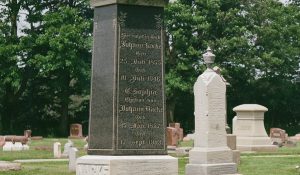
The picture to the left is a crop of the cemetery picture in the gallery above. I had the camera set to 100′ focus distance and an aperture of f/16. That gravestone was a bit closer to me than 100′ but it still fell within the depth of field for an f/16 aperture.
The colors were also surprisingly accurate for an uncoated lens. It wasn’t typical for lenses to have coatings for color photography until after World War II. That doesn’t mean you still can’t shoot with color film (I did), but usually you get some muted colors, or pictures that suffer from flare that can affect the color accuracy.
There is no doubt in my mind that this wasn’t a top of the line camera in 1916. To think that 99 years later, using film that wouldn’t be invented until decades later, the camera still makes excellent exposures with sharp and accurate colors.
Now for the “less good”. There were some mild traces of light leaks in a couple of the shots, but that could be from the red window for the frame counter on the back of the camera. When this camera was made, film was a lot less sensitive to light, so any amount of light that could leak through this red window wouldn’t have any affect on the film. Although I was using 100 speed Kodak Ektar, this is still quite a bit faster than anything that would have been around in 1916, so more special care is needed to block stray light rays from entering through this window and leaking onto the film. Had I used a faster film like 400 or higher, it would have been even more pronounced.
Also, out of the 8 shots on the roll, 4 of them were several stops underexposed. I don’t yet know how this happened. I paid very careful attention to my exposure settings and tried to make sure that I had the exposure correct. I show 2 of the 4 underexposed shots in the gallery above, and for both of them, I was able to salvage a decent shot using Photoshop, but I would have preferred it be correct in the camera.
What worries me is that all 4 of the underexposed shots were the last 4 of the roll. I hope that something didn’t give in the shutter and cause the second half of the roll to not fire accurately. The shots in the top row of the gallery are all pretty spot on, but everything after that isn’t. I am just going to hope that this was user error, and I didn’t pay close enough attention to my lighting. I am told that Ektar is extremely unforgiving with exposure, so maybe that’s all it was. Whenever I take the camera out and take more shots, I will be very careful to record my exposure settings.
Despite the dark shots, I was pretty satisfied with the results. This camera is a LOT of fun to use, and its really nice not having to fiddle with any adapters when loading my film. My only other Kodak folder was designed for 116 film which is larger than 120, so it can take 120 film if you use an adapter. I wont say it would be a camera I will regularly use, simply because of the effort required to use it, but I could definitely see it being useful for some family portraits or some nice landscape photography.
| My Final Word | It doesn’t get much cooler than this, a 100 year old camera that was built with the highest standards and top of the line technology of the day. This camera had many firsts, and was extremely well built. They are very hard to find, and when one does go up for sale, they are often described incorrectly meaning you can pick these up for a bargain, but even if one is correctly labeled and priced, it’s worth buying, regardless of price. If you’re still on the fence, there aren’t many turn of the last century folding Kodaks that natively support 120 film, this one does. | ||||||
| Images | Handling | Features | Viewfinder | Feel & Beauty | History | Age | |
| 1 | 1 | 1 | 0 | 2 | 2 | 50% | |
| Bonus | +1 for its pioneering shutter design, Zeiss glass, first use of Bakelite plastic, quick load film system, and rack and pinion focus system | ||||||
| Final Score | 11.5 | ||||||
Additional Resources
http://mconnealy.com/vintagecameras/no1special/index.html
http://www.nwmangum.com/Kodak/Rochester.html
http://photo.net/classic-cameras-forum/00XEw0
http://photo.net/classic-cameras-forum/00PNvM
http://forum.mflenses.com/no-1-autographic-kodak-special-model-a-t49518.html
http://throughavintagelens.com/2009/11/selecting-a-vintage-camera-ii-kodak-cameras/


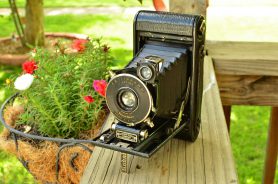
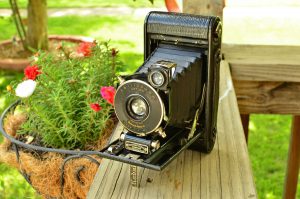














Nice pick up! Though you find your results hit and miss, there is still quite a bit to like in your results. I’ve shot with a 116 (Anstigmat lens) and a 122 (Bausch and Lomb Rapid Rectilnear) format Kodak folder, but didn’t get results I like as much as the first two shots you display here. I find folding cameras to be a fun adventure in ways that more modern cameras lack, a kind of fun that few people are willing to risk the expense and frustration of, but a rewarding fun when you get it right.
Thank you Adam for the kind words! 🙂 In the moments after I got that roll back, I was a bit disappointed that the rest of them didn’t turn out better, especially since I felt like I was really diligent about getting the settings right. In the time since, the fact that I got as good of results as I did for a 99 year old camera that required nothing more than a basic wipe down is pretty impressive. I keep saying I am looking forward to my second roll, but I am waiting for an opportunity to actually take it somewhere and actually get some worthwhile shots worthwhile of taking! 🙂 When I get some more film developed back from this camera, I will be sure to email you with the email you used for this post! 🙂
I definitely understand that feeling of disappointment after a roll like this. It’s tough when you cross your T’s and dot your I’s in exposure and focus only to be lukewarm to the results. My first roll of Velvia in the 122 camera yielded one really nice shot, but the roll of Ektar was very yawn worthy. They’re in my blog link if you want to see them. I’m definitely interested to see what you get from a follow up roll, but definitely understand that you’d want to use the camera for keeper shots. 6×9/6×11/6×14 isn’t a cheap format! 🙂
A very good review and assessment of this outstanding camera. My model has the No3 Bausch-Lomb Tessar Series II B Pat Feb 24 1903 sr. 2448963 lens and the last pat. date in the USA on the film take-up carrier is June 19, 1917. On the film supply carrier the last Pat. date in Canada is March 19, 1915
I have one of these cameras, but I cannot get the front of the thing to open. Did it require a key to open the front so that you can extend the camera? Your review is excellent and has renewed my interest in getting it open.
Shelby, I am happy to hear that my review has renewed your interest in this camera. If its in good shape, you should be very pleased with the images it makes. As for opening it up, there is no special key, just a button. In the review, I show an image of the back of the camera. The button is a raised spot under the leather near the red window. You should see a prominent bulge in that area. Press it while gently trying to separate the two halves of the body.
I just wish I could still buy the right size film. I would love to see what came out of a really huge negative like some of them had.
Hi Mike,
You (and other) may be interested in a brief review of this camera (No. 1 Autographic Kodak Special (model A)) and its successor (No. 1 Autographic Kodak Special (model B)) that I made in a photography forum in Spain: http://manualens.com/foro/index.php/topic,25296.0.html; It is, of course, in Spanish, but I suppose that the solution will be a good online translator (Google translator, if there is no other alternative).
I have added your own analysis of the camera, which I find very interesting, as one of the links at the bottom.
Just add that since I published the review (October 2018), I have gotten another No. 1 Autographic Kodak Special (model A) that incorporates a Compur shutter and a Bausch Lomb Kodak Anastigmat No. 1 lens, f / 6.3 of which The focal length is not specified, although the patent that covers it is: PAT. FEB. 24.03.3053112, I assume it will be a Zeiss licensed copy of the Tessar. From the serial number of the Compur dialset type shutter (s/n 481243) I assume the camera is from 1921, just before the start of production of the Model B.
Best regards